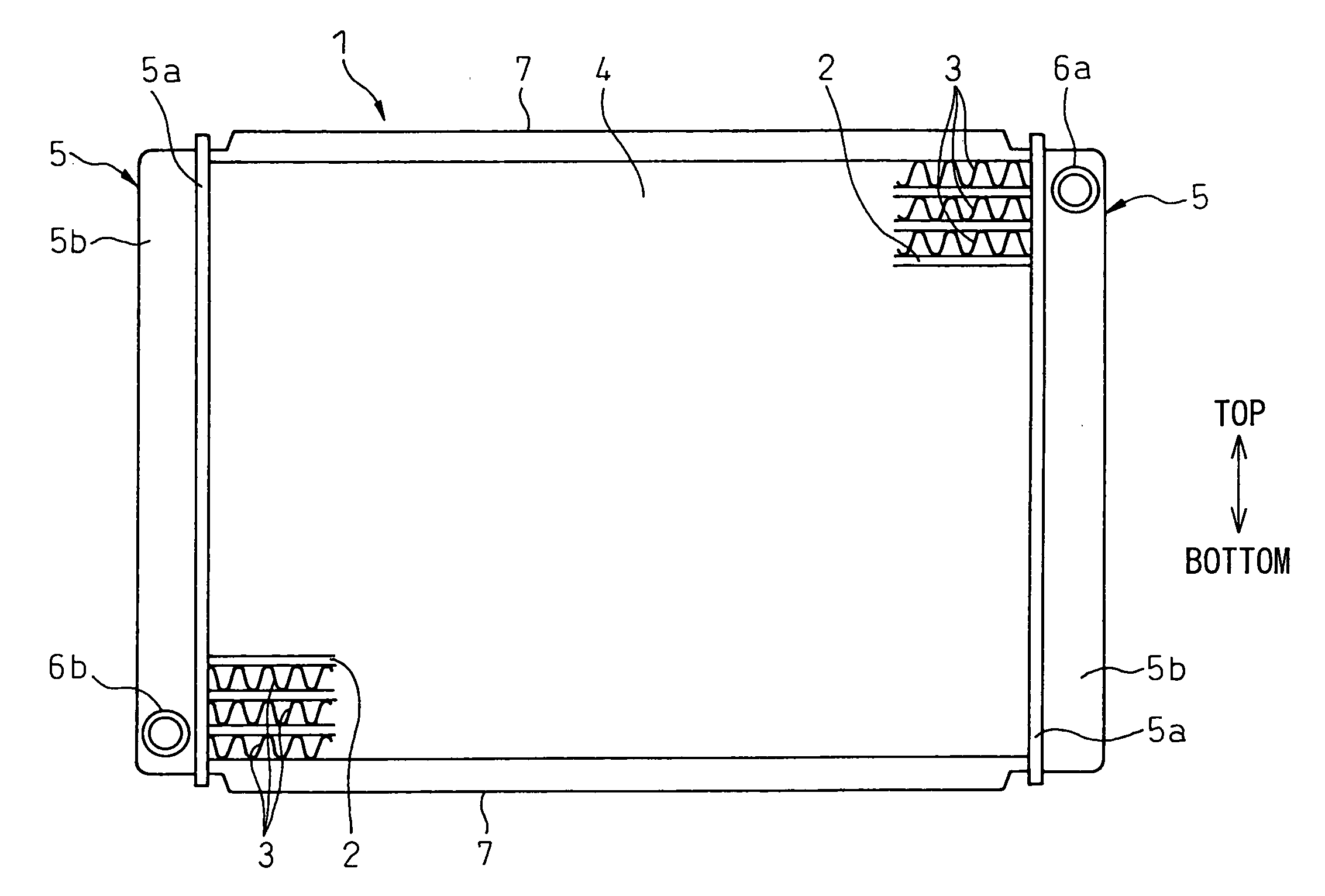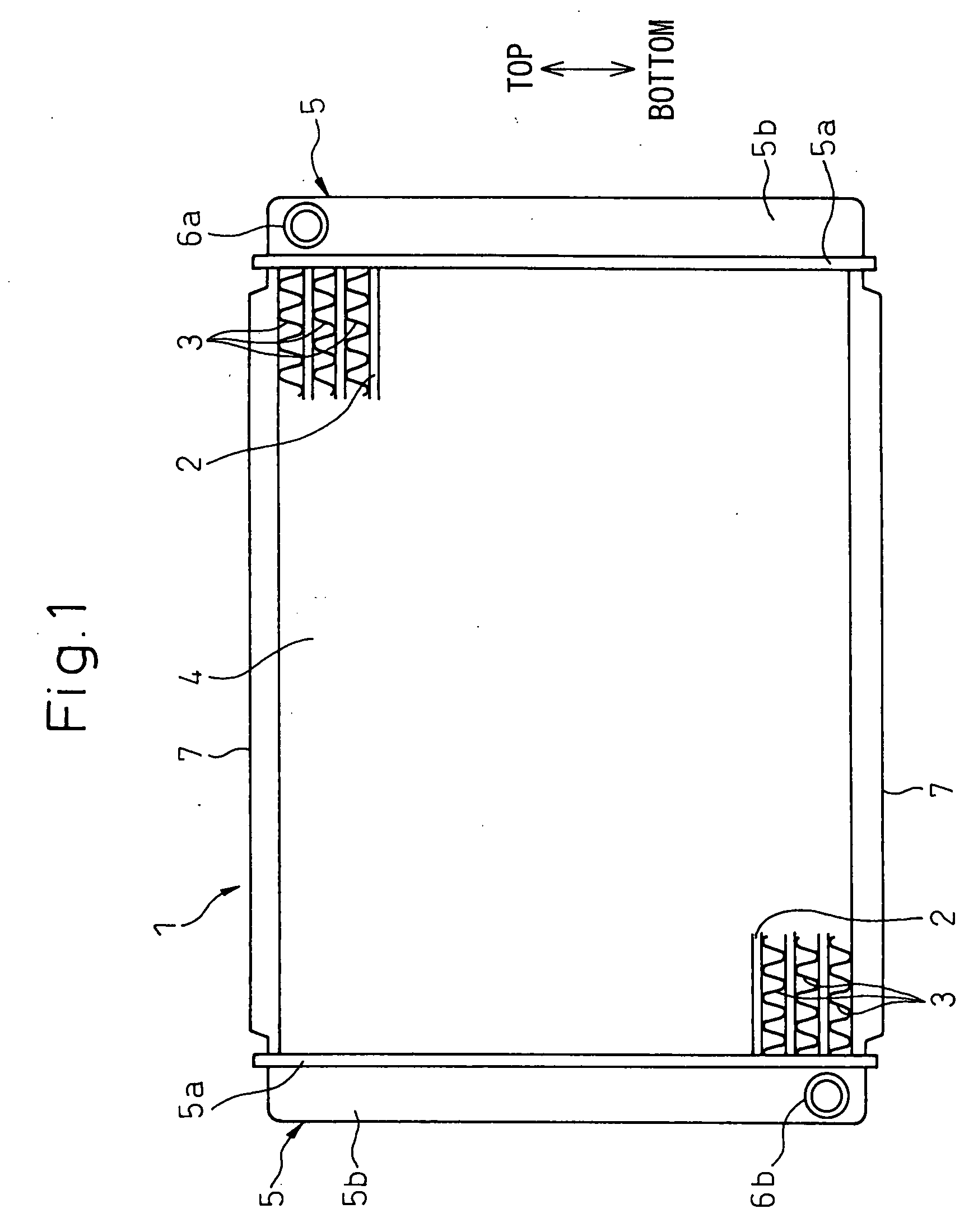Heat exchanger
- Summary
- Abstract
- Description
- Claims
- Application Information
AI Technical Summary
Benefits of technology
Problems solved by technology
Method used
Image
Examples
first embodiment
[0102]FIG. 2A is a plan view showing the insert 7 and FIG. 2B a front view of FIG. 2A. As shown in FIGS. 2A, 2B, the insert 7 includes a base portion 71 having a surface substantially parallel to the flat surface 2a of the tubes 2 and extending in the direction substantially in parallel to the length of the tubes 2 and a pair of ribs 72 projected from the ends of the base portion 71 along the air flow in the direction (direction of tube stack) substantially perpendicular to the base portion 71 and extending in a direction substantially parallel to the length of the tubes 2.
[0103] The pair of the ribs 72 of the insert 7 are formed with notches 73a, 73b, respectively, cut inward in the direction of the tube stack from the outer end of the ribs 72 in the direction of the tube stack. Also, the notch (hereinafter referred to the upstream side notch 73a) formed in the rib 72 on the upstream side in the air flow and the notch (hereinafter referred to as the downstream side notch 73b) form...
second embodiment
[0119] As a result, effects similar to those of the second embodiment are produced.
[0120] Further, in view of the fact that the two base portion-side expansions 74a, 74b are tilted in opposite directions in the direction of air flow, the spring back when molding the base portion-side expansions 74a, 74b can be reduced for an improved moldability.
[0121] Next, a fourth embodiment of the invention will be explained with reference to FIGS. 5A, 5B. In FIGS. 5A, 5B, component parts similar or identical to those of the second embodiment are designated by the same reference numerals, respectively, and are not described again. FIG. 5A is a plan view showing the insert 7 according to the fourth embodiment, and FIG. 5B is a front view of FIG. 5A.
[0122] As shown in FIGS. 5A, 5B, the base portion 71 of the insert 7 according to this embodiment is formed with two slits 75. According to this embodiment, the two slits 75 are arranged with the length thereof substantially parallel to the length of...
seventh embodiment
[0142] As a result, effects similar to those of the seventh embodiment described above are achieved.
[0143] Next, a ninth embodiment of the invention will be explained with reference to FIGS. 10A and 10B. In FIGS. 10A and 10B, component parts similar or identical to those of the seventh embodiment are designated by the same reference numerals, respectively, and are not described again. FIG. 10A is a plan view showing the insert 7 according to the ninth embodiment, and FIG. 10B a front view of FIG. 10A.
[0144] As shown in FIGS. 10A and 10B, the base portion 71 of the insert 7 according to this embodiment is formed with four notches 76. Of the four notches 76, two (hereinafter referred to as first notch portions 76c) are formed by cutting the base portion 71, from the upstream end toward the downstream end in the air flow. The two other notches (hereinafter referred to as a second notch portion 76d), other than the first notch portion 76c, on the other hand, are formed by cutting the b...
PUM
 Login to View More
Login to View More Abstract
Description
Claims
Application Information
 Login to View More
Login to View More - R&D
- Intellectual Property
- Life Sciences
- Materials
- Tech Scout
- Unparalleled Data Quality
- Higher Quality Content
- 60% Fewer Hallucinations
Browse by: Latest US Patents, China's latest patents, Technical Efficacy Thesaurus, Application Domain, Technology Topic, Popular Technical Reports.
© 2025 PatSnap. All rights reserved.Legal|Privacy policy|Modern Slavery Act Transparency Statement|Sitemap|About US| Contact US: help@patsnap.com



